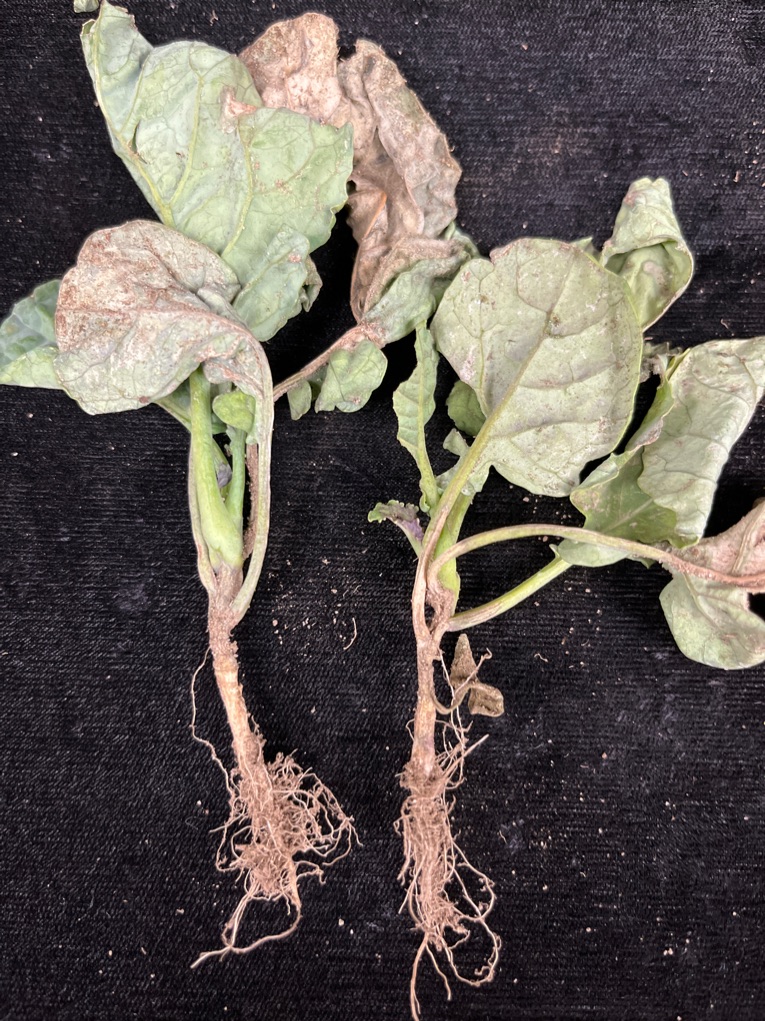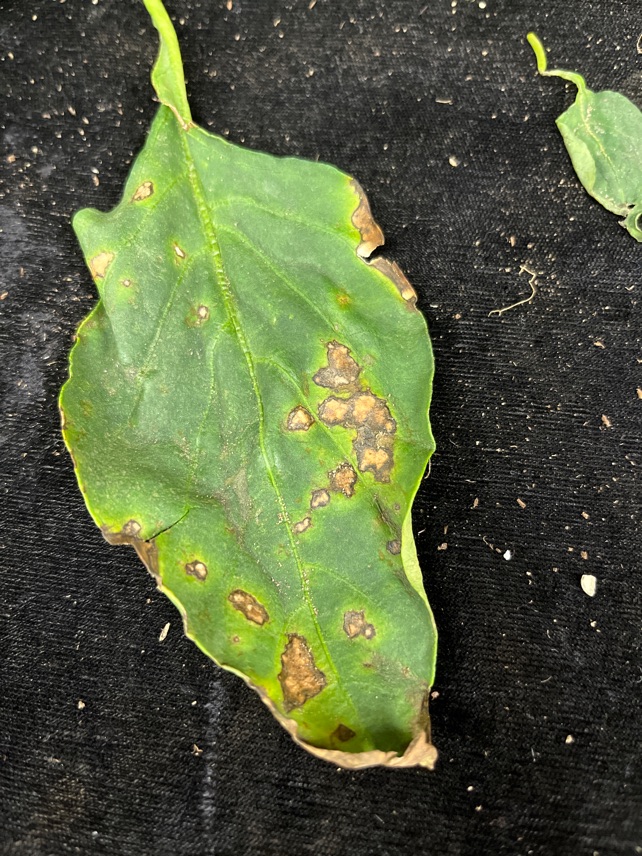Michigan vegetable crop report – August 24, 2022
Abnormally dry and moderate drought conditions in the Bay and Thumb area of Michigan have made for an excellent vegetable season thus far. Other areas of the state have received fairly well-timed rains, and sometimes too much.

Weather
Watch Jeff Andresen's weather update here.
Abnormally dry and moderate drought conditions in the Bay and Thumb area of Michigan have made for an excellent vegetable season thus far. Those clay loam soils are resilient to these conditions. Other areas of the state have received fairly well-timed rains, and sometimes too much. Phytophthora flareups have been reported.
The forecast calls for:
- Continued fair and dry central and south Wednesday, increasing clouds with scattered showers possible northwest by late in the day continuing overnight.
- Scattered showers and thundershowers possible statewide Thursday with best chances for rainfall north.
- Clearing, dry and cooler Friday and Saturday. Showers and thunderstorms possible again north late Sunday and statewide on Monday and Tuesday.
- Daytime temperatures mostly in the upper 70s to mid-80s through Wednesday, cooling to the mid-upper 70s by Saturday. Lows generally from the mid-50s N to low 60s S.
- Medium range guidance calls for a return of warmer temperatures with variable precipitation totals. New long lead outlooks generally call for near to above normal mean temperatures and near to below normal precipitation totals.
Weed to watch for
Now is a great time to identify puncture vine. For much of its life cycle it looks like a locust tree seedling or hairy vetch. But the yellow flowers are more like small buttercups unlike a legume flower, and the seed pods are the real clincher. Like various other sticker-seed plants, they hitch a ride on clothes and animals. However, puncture vine seeds are tough enough to puncture the rubber on boots and tires too! Read more in “Puncturevine: Another weed to add to your watch list” by Michigan State University Extension, or view more pictures of puncturevine.
Crop updates
Asparagus
Purple spot has continued to develop, and growers may be antsy to put the sprayer away after a long season. How can you tell whether to “put the sprayer away after Labor Day?” Disease Severity Values can be helpful. As we move into September, keep an eye on these. If we continue to some get days each week with 1s and 2s and occasional 3s, it suggests it is worthwhile to continue thinking about fern covers. Don’t forget that even if overnight lows are cool, dews that persist into the day when temperatures warm can allow for DSV accumulation. Consider that good purple spot control in the fern stage will also limit inoculum that can infect spears during harvest.
New shoots are coming up in many fields given the recent heavy rains, with new growth on older stems too. Some of the shorter, new shoots have that “I’m going to die,” crooked look. From a photosynthesis and carbohydrate perspective, as we get to the end of August it becomes less likely these shoots will pay back the plant anyways.
Carrots and celery
Carrots are doing well in west central Michigan, with moderately warm days and cool nights. Harvest is underway in Imlay City. One celery grower remarked once, “Celery is comfortable when we are.” That’s also true for carrots!
Cole crops
Now is the time to maintain vigilance for bacterial soft rots and Alternaria leaf spot and head rots on broccoli and cauliflower. Alternaria has surpassed black rot as the disease driving spray decisions in the fall-harvested crop slot. It’s a real bugger as the frequency of dewy mornings increases. Preventative actions include anything that improves air drainage, prompt crop destruction of older plantings, clean seed, a three-year rotation out of any brassica (including cover crop mustards, radishes or turnips), and brassica weed control in rotation years are good preventatives.
A sample came to the lab exhibiting wirestem symptoms this week.

Cucurbits/pickles
What can be done about early ripe pumpkins? Those fruits have a long way to go until the Halloween season, but pumpkins and squash are well-known for their shelf life among vegetables. I kept a spaghetti squash for almost a year once. The key is to let them cure and to keep them in a dry place under 70 degrees Fahrenheit. They cure best in the dappled shade of their own healthy leaves, building a waxy layer and hardening in full color. If keeping the foliage healthy is not an option, they should be removed from the field to avoid sunburn and allowed to cure under a tree or drafty barn. The biggest challenge off the vine will be dewy mornings and hot temperatures.
Interestingly, I see this problem every year with individual growers who are absolutely nailing it in their evolution as professional farmers. They make an investment to improve a process, like using transplants instead of seeds to offset losses from mice or birds, or plant on plastic to fertigate or avoid in-row weeds. But, then the result of those actions is an earlier pumpkin.
Fruiting vegetables
Pathogen or sunscald in peppers? It can be hard to tell the difference sometimes, especially since secondary organisms can colonize sunscald spots. Longer peppers can develop blossom end rot in the same areas that the sun reaches beyond the cover of leaves.
Sunscald is diagnosable as large spots on peppers exposed to the sun. It appears more on western sides of plants in north-south rows, and southern sides of plants in east-west rows. Sometimes this happens as one fruit is picked, or a plant is moved, exposing another. Pathogens will infect fruit regardless of sun exposure.
Blossom end rot occurs on fruit anywhere on the plant, typically on the ends of the fruits, and is associated with irregular irrigation under heavy fruit load. Some varieties exhibit the symptoms more than others.
Anthracnose is one pathogen that can cause fruit rots in peppers in late summer and fall. It is an aggressive pathogen that can cause major losses, and is worth proactively managing with fungicides. Read more in this short but sweet article from Ohio State, which also includes fungicide recommendations.
Bacterial leaf spot caused by Xanthomonas causes spotting on the foliage; it typically doesn’t cause lesions on the fruit. Severely affected foliage will drop off the plant leaving the pepper fruit vulnerable to sunscald.
Internal rots are another can of worms that can eventually become external rots when ripening peppers to a full color. The pathogens that live inside fruit are actually quite common but are not often observed until cutting them open. Riper fruit with higher sugar content, and environmental conditions at the end of summer, allow them to proliferate inside fruit. Last week I mentioned how conditions at bud-formation can affect fruit shape. Internal rot pathogens make their entry into the hollow centers of fruit at bloom time. Read more about internal rots from Applied Horticulture Research.

Onions/garlic
Harvest and piling of storage crops are underway. Soft rots in sweet onions are a common malady. The blame is often placed on wet conditions at dry down, but the pathogens that cause internal rots are often on their way into bulbs before then, and there are differences in susceptibility that comes down to cultivar. Candy onions have the highest incidence of internal rots at harvest. This also happens to be the most popular sweet onion to grow due to an industry set up to provide bare-root transplants in Arizona and Texas that favors Candy.
However, research from Penn State has shown that there are other varieties of onions that yield similarly or better than Candy, with comparable flavor profiles (Tables 2 and 3 in this study), including Expression and Spanish Medallion. An older suite of studies in southwest Michigan trialed several varieties as well, with comparable yields to the Penn State studies, but Candy was not a part of those trials, and flavor profiles were not compared. One would need to grow them from seed in a greenhouse themselves, and that is the biggest barrier to adoption for many growers.
According to another Penn State study, an additional factor contributing to center rots in onions are soil temperatures at bulbing. For those using black plastic mulch, these effects could be amplified.
Sweet corn
Corn earworm captures increased to about two to five per night at an Oceana and Ottawa County wire trap, and scouts have reported variably high and low catches. To date, west central growers and scouts have not observed major issues, with very few worms in ears. However, given field corn is done silking, it makes sense to be conscientious about product choice and spray intervals when and where catches are increasing.
Pyrethroids can be helpful at lower trap captures, but where they are higher, products containing the active ingredients chlorantraniliprole or spinetoram are helpful. There are both one-active versions of these (e.g., Coragen and Vantacor for chlorantraniliprole, Radiant for spinetoram) as well as pre-mixes with pyrethroids (e.g., Besiege, Elevest) or other insecticides (e.g., Intrepid Edge). Tightening spray intervals is also important as captures increase.
Tassel ears were reported this week. This shows up sometimes in sweet corn. I have seen it most often in skinny rows of plasticulture corn with a lot of space on either side, and on rows that stick out farther than others because seed ran out. The environmental trigger is not known, but having extra space seems to be one factor that brings it out. This Purdue Chat ‘N Chew article describes it similarly, but adds that it most often occurs on the tillers, and not the main stalk.
Events
- Aug. 25: 2022 Tile Drainage Field Day at 13000 Bird Lake Rd, Camden, MI.
- Sept. 8: Field Day at the Northwest Michigan Horticulture Research Center. The center is located at 6686 S. Center Highway in Traverse City and will highlight Michigan fruit advancements.
- Sept. 8: Oceana Research Tour featuring asparagus and carrots. Call 231-873-2129 for more details.
- Sept. 14: Mechanical Weed Control Field Day at the Southwest Michigan Research and Extension Center, 1791 Hillandale Rd, Benton Harbor, MI.
- Tell Crosshatch and their partners how the next Northern Michigan Small Farm Conference should look. Please complete this 5-minute survey to help shape the next conference.
This work is supported by the Crop Protection and Pest Management Program [grant no 2021-70006-35450] from the USDA National Institute of Food and Agriculture.



 Print
Print Email
Email

